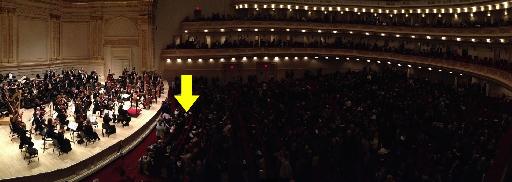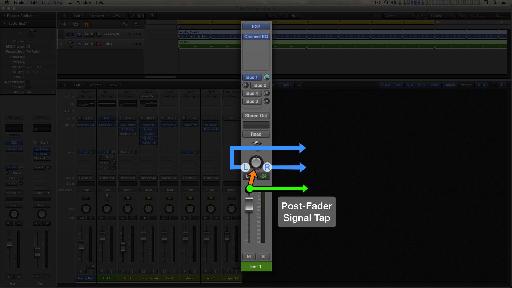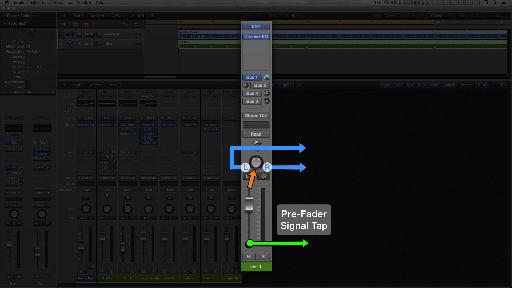وكان مصدر إلهام لي لكتابة هذا المقال بعد مناقشة الوضع مع العديد من الملحنين الذين سعوا نصيحتي حول كيفية وضع مزيد من التباعد بين المستمع والصوت المباشر للعينات. وبعبارة أخرى، كان الهدف النهائي لمحاكاة ما يبدو الأوركسترا مثل من وجهة نظر أحد أفراد الجمهور يجلس في الصف الأوسط من قاعة الحفل، بدلا من الصف الأول أو حتى أقرب إلى موصل sourcethe أو لاعبين المواقف. على الحل المقترح: تعيين تردد من يرسل أن يكون قبل ترويسة بدلا من بعد ترويسة.
الآن، إذا كنت لم تكن مألوفة مع هذه الشروط، لا تقلق. شرح سوء المصطلحات وكذلك المبدأ الكامن وراء هذا النهج الهندسية (التي تعمل متعود 99٪ من الوقت، ولكن سوء وصول إلى ذلك). أولا، يتيح استكشاف ما يحدث بشكل طبيعي في قاعة الحفل عند سماع فرقة موسيقية على مسافة.
في الغرفة
عندما المشاريع سليمة من مرحلة في قاعة للحفلات الموسيقية، فإنه يبدأ على الفور إلى reverberatereflecting قبالة الجدران والسقوف، والأرضيات، والاختلاط في مع الصوت المباشر من الصكوك على خشبة المسرح. عموما، صوت تردد في حد ذاته هو طمس الصوتية، وانخفاض في الإخلاص وأقل تفصيلا من الصوت المباشر. وأبعد من ذلك كنت في الغرفة، ومشوشة يصبح الصوت كما يميل التوازن بين المباشر (الجاف) الصوت والصوت reverberant (الرطب) نحو الرطب. تأثير الجلوس أقرب أو أبعد عن الأوركسترا هو لا يختلف كثيرا عن الوقوف مع أنفك فقط بوصة بعيدا عن لوحة فنية، بالمقارنة مع ما يوود معرفة ما إذا كنت وضعت على النظارات ذات العدسات متجمد.
التوضيح A
التوضيح B (ضبابية عمدا)
وهكذا، عندما تريد الأوركسترا أن ينظر إليها على أنها سمعت بعيدا عن المسرح، كنت أريد أن أسمع أقل إشارة مباشرة وأكثر من ضبابية، تردد غير واضحة. ثت، المبدأ الأساسي بسيط. هناك نوعان من الأساليب الهندسية مزيج يمكننا اتخاذها لمحاكاة هذا: رفع مستوى مخرجات ريفيربس أن يكون أعلى من المعتاد، أو خفض مستوى جميع الإشارات الجافة وترك مستوى تردد حيث كان. وفي كلتا الحالتين، فإن النتيجة تكون هي نفسها: انحراف ميزان الرطب / الجافة نحو الرطب.
فكيف سيكون من يرسل هذا الإعداد أن يكون قبل ترويسة يمكن تحقيق هذا الهدف؟ هيريس الجواب: في معظم الحالات، فإنه غير قادر. إذا كان أي شيء، وهذا النهج التخلص من رصيدك الرطب / الجافة بمجرد تحريك المخفون تدريجيا أثناء الخلط. ولمعرفة السبب، ويتيح مراجعة لفترة وجيزة جدا كيف يرسل العمل.
إرسال أساسيات
الطريقة التقليدية لإضافة تردد لأصوات متعددة في مزيج هو ارسال اشارة من تلك القنوات على تردد المساعد المشترك. يتم ذلك، بطبيعة الحال، عن طريق تكوين الإرسال على كل قناة لإشارة أنابيب على طول حافلة مشتركة لأن تردد (انظر الشكل 1).
الشكل 1: قناتين إرسال إشارة إلى تردد مشترك.
وهكذا، وكم تردد تضيفها إلى صوت (من الناحية الفنية، وكم إشارة ترسلها إلى تردد) هو مجرد مسألة وكم كنت تحويل ما يصل الإرسال. ولكن ما إذا كان هذا المبلغ من تردد يبقى ثابتا على مدى مدة جزءا يعتمد على كيفية النقطة بالضبط من داخل القناة أن يحصل إرسال إشارة لها من بينها. وهذا هو المكان الذي يأتي كله شيء قبل ترويسة / بعد ترويسة حيز اللعب.
التنصت النقاط
الشكل 2: إشارة الصنبور بعد ترويسة.
التكوين الافتراضي ليرسل في الأجهزة والبرمجيات خلاطات هو بعد ترويسة، حيث الصنابير لإرسال إشارة من نقطة بعد ترويسة لها تأثير على مستوى الحجم الإجمالي للصوت (الشكل 2). ومع ذلك، وليس من غير المألوف أن تجد خيارا لتغيير نقطة الحنفية أن يكون قبل ترويسة، حيث يتلقى إرسال إشارة من نقطة قبل ترويسة ديه أي وقت مضى فرصة للتأثير على مستوى (الشكل 3).
الرقم 3: إشارة الصنبور قبل ترويسة.
مع الإرسال بعد ترويسة، فإن كمية الإشارة المرسلة إلى تردد أن يكون دائما في نسبة مستوى ترويسة. ركوب ترويسة أعلى / أسفل يعني أن أكثر / أقل إشارة يحصل على تردد، على التوالي. الاتجاه الصعودي لهذا الترتيب هو الاتساق: بعد الاتصال الهاتفي في مبلغا أوليا قدره تردد على الإرسال، بغض النظر عن مدى أنت تركب مستوى الصوت من جزء في حين خلط، فإن الإشارات الجافة والرطبة يكون دائما في نسبة إلى بعضها البعض. هذا يمكن أن يسمع في المقطع الصوتي التالي، حيث يلعب نفس التو الناي مرور twicefirst مع ترويسة وضعت في صفر، ثم مع ترويسة وضعت في -12 ديسيبل.
مثال الصوت 1:
[معرف الصوت = "33980"]
على العكس من الاتساق
الآن دعونا نتصور ما يمكن أن يحدث إذا ضبط ترويسة لم يكن لها تأثير على كمية من إشارة إرسالها إلى تردد. على سبيل المثال، دعونا نقول لكم كان الجزء الذي عقد لفترة طويلة جدا وأردت أن تتلاشى من ذلك عن طريق خفض ترويسة. إذا كانت ترويسة أي تأثير على مستوى إشارة إرسالها إلى الفعل، فإن الصوت بشكل مستمر ومباشر إطعام إشارة إلى أنه حتى بعد أن تلاشى تماما من الإشارة الجافة. تواصل يوود لسماع الصوت شبحي للتردد بعد فترة طويلة كنت تلاشى إشارة الجافة: النتيجة.
قد يؤدي هذا إلى تأثير بارد، لكنه ينفي الغرض الأصلي. حتى الآن دعونا لا تتخيل ولكن نسمع هذا حقيقي. في هذا المثال الصوت الأول سماع مذكرة متواصلة مع تردد بعد ترويسة (وبنقرة والمسار) الذي يستمر التدابير longtwo جدا بدلا من واحد يوول:
[معرف الصوت = "33978"]
المقبل، وتلاشى إيف الناي في نهاية قياس واحد، مع تردد الإرسال المنصوص بعد ترويسة. سيتم إسكات إشارة الجافة وإلا الجزء الأخير من الصوت الذي ضرب تردد سوف ترن في تردد.
[معرف الصوت = "33979"]
الاستماع الآن لصوت يتلاشى في نفس الطريق، ولكن حيث يتم تعيين الإرسال أن يكون قبل ترويسة. سوف إشارة الجافة تتلاشى في الواقع، ولكن الصوت الذي لا يزال بعد قياس واحد هو تردد بحتة.
[معرف الصوت = "33977"]
الذي يكون قبل ترويسة يا!
في الواقع، مع ما قبل ترويسة ترسل، عند ضبط ترويسة تفقد السيطرة على التوازن بين إشارة الجافة والرطبة عند تحريك ترويسة.
تحدث مشكلة متساوية والمعاكس عند رفع ترويسة. هنا، فإن إشارة الجافة الحصول على أعلى صوتا وتصبح أكثر مباشرة دون أي زيادة في مقدار يتردد الصوت في الغرفة. هذه الهزائم الغرض كله من إبعاد المستمع من الصوت عن قرب. كلما علا جعل لكم جزءا منها، وأثر هو نفس التحرك جسديا هذا اللاعب أو مقطع أقرب إلى المستمع! (انظر الشكل 4).
الرقم 4: رفع ترويسة مع الإرسال قبل ترويسة له تأثير تحريك لاعب أقرب إليك!
كيفية تحقيق ذلك الاوسط الصف الصوت
الحل هنا هو بسيط جدا. أولا، لا عناء مع ما قبل ترويسة ترسل. تركهم المقرر أن تكون بعد ترويسة-يمنحك القدرة على ضبط مستوى جزء والحفاظ على التوازن الرطب / الجافة الذي طلبته في على مقبض الإرسال. لتحقيق صوت الشامل رطوبة، كما لو أن المستمع هو أبعد من مرحلة، ورفع مستوى الانتاج من ريفيربس الخاص بك (من السهل القيام به)، أو خفض مستوى كل من الإشارات الجافة الخاص بك (أصعب من ذلك بكثير). معرف توحي النهج الأول. بسيطة جدا!










 © 2024 Ask.Audio
A NonLinear Educating Company
© 2024 Ask.Audio
A NonLinear Educating Company
Discussion
BTW- LOVE all of your MPV videos!!!! 👌ðŸ½
The technique you mentioned is fodder for a whole series of articles. Or a book LOL! There are soooo many ways to control volume and dynamics, and depending on which one you use will determine its effect on the reverb balances and ultimately the mix. But regarding CC#11, it's not implemented i the same way in every sampled instrument. In EastWest Hollywood Strings, for example, CC#11 affects what we could call "true instrumental dynamics" because it's controlling sample crossfading. But in their EWQL Orchestra, CC#11 only controls volume -- no different from using CC#7. Many other instruments respond to CC#11 by only controlling volume, and then there are those which don't respond to CC#11 at all.
Of course, this situation makes it hard to work consistently from one instrument to another, so my approach is to ride volume exclusively with faders -- and that makes the choice of post-fader sends critical for this kind of approach. Otherwise my virtual players would be sonically flying into the audience when I goose the volume, and retreating backstage when I tuck them back in the mix. :)
-Your humble "apprentice".
Guru? Me? Oh man, I don't know what to say but thank you! (I don't take compliments well). Moving swiftly along... ;)
This is a tough question to answer, so I'm going to offer just very general guidelines...
If you tend to make significant volume rides on the Auxes (subgroups) for each instrument family, then the reverb send(s) should be on the Aux, and they should be post-fader. Here's an extreme example to illustrate the point, and there are 3 scenarios to consider, and they all involve post-fader sends...
Your trumpets and their reverb balances sound perfect. But they're too loud overall in the mix. Typical trumpet players, right? (LOL) So you bring down their subgroup -12 dB.
1• If you have *no* reverb sends on the individual trumpet instruments, but you did have sends on the subgroup (the Aux), when you lower the subgroup's fader you'll maintain the balance of reverb vs. dry signal on the trumpets overall. This is because a post-fader send ensures that the proportion of dry and wet signals is maintained when you adjust the level.
2• If you *did* have reverb sends on the individual trumpet instruments and *no* reverb send on the subgroup, turning down the subgroup's fader would result in a much wetter-sounding trumpet ensemble. The dry signal would be lower, but you won't have affected the amount of reverb being sent from the individual channels, hence the result would be lower (dry) trumpets with the same amount of reverb as before.
3• If you have sends on both the individual channels *and* the subgroup, lowering the subgroup's fader will result in a simultaneous reduction in both the level of the dry signal *and* the amount of reverb on the trumpets overall. However, the balance of dry signal to reverb you'll be left with might be quite different from what you had before. It all depends on how (or if) the reverb amount on each trumpet was different or not. Here, the subgroup's send adds reverb to your trumpets "globally" and equally for the entire ensemble.
It's a difficult call as to use #1 or #3. Number 2 is definitely not the way to go.
As I said in my previous post, this is fodder for a book or video course because of all the different permutations of signal flow possibilities and ultimately, what it actually sounds like (which might be great) even if you do things "wrong", if you know what I mean.
Hope that helps!
Want to join the discussion?
Create an account or login to get started!